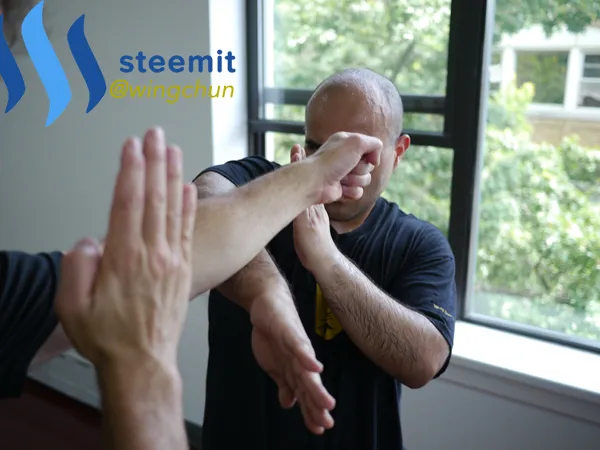Hi everyone before I get started with some kung fu lessons on steemit I thought it would be best to first talk about Wing Chun for those not familiar with the art.

Wing Chun is a southern Chinese martial arts style (I will discuss the history in the next article). Wing Chun practitioners are well known for their specialty in close range combat.
This martial arts style is based on concepts and principles such as simplicity, economy of movement, and economy of energy. Practitioners utilize economy of movement by combining coordinated angular deflections with simultaneous attacks. A Wing Chun practitioner is agile yet powerful, delivering quick, close range punching and kicking skills rather than locks and grabs.
Wing Chun does not rely on size or strength. Practitioners assume their attacker is going to be bigger, and stronger, they might have weapons and most likely will not be alone. Therefore, practitioners rely on techniques that do not use strength, but rather deflection and redirection. Moves that rely on brute strength just don’t work if you attacker is stronger than you, which will most likely be the case. Smaller weaker people generally don’t attack someone who can out power them, at least not unarmed or alone.
Wing Chun Training Overview
There are many aspects to Wing Chun training that make it unique to other art forms.

FORMS
Sil Lum Tao - Teaches how to form a good base, the fundamental hand positions, and how to move one’s energy away from one’s body through the center-line. This is the dictionary of our system.
Advanced Sil Lum Tao - Teaches how to form a good base, the fundamental hand positions, and how to move one’s energy away from one’s body through the center-line. In addition, this form teaches the start of footwork/hand coordination (unification of movement).
Chum Que - Teaches proper assessment of angles (hands and feet) and angle structure to allow safe movement while bridging the gap. It also coordinates multiple movements from Sil Lum Tao in combination.
Bil Gee - Teaches the wrist rotation movement for finger thrusting, the elbow rotation for elbow strikes, recapturing the center-line, and additional footwork and coordinates additional hand movement.
NOTE: In Wing Chun, forms do not teach application. Attempting to impose application on the movements in the forms will only serve to restrict their usefulness in battle.
Wooden Dummy - The Wooden Dummy translates the movements and positions in the forms into textbook/root applications.

Bart Jarm Dao - This is a beautiful form which is more widely trained as a classical piece of this system. This form has amazing applications that can be used in knife fighting techniques.
Dragon Pole - Used today to keep the classical part of the system alive. Wong Wah Bo added the Dragon Pole to the system from the Red Opera (Hung Suen Hei Ban). Used as a long-range weapon.
Other Training Modalities
Chi Sao - Not a form of sparring and should never be viewed as such. Utilizing chi sao as sparring totally defeats its purpose. Chi sao is used to develop contact reflexes and the ability to interpret movement through touch.

Self - Defense Sets - For the purpose of simulating possible street encounters and should simulate as closely as possible real-life threatening situations.

Battle Sets - Pre-arranged applications against various attacks.
Flow Drills - Random defense against various attacks. This is a great time for practitioners to experiment with what they have learned.
Flow Drills - Random defense against various attacks. This is a great time for practitioners to experiment with what they have learned.

Micro Study Sparring - Light sparring (not prearranged) where one can practice new applications in a less threatening atmosphere.
Full Contact Sparring - Full contact, virtually anything goes sparring. Protective gear should be worn for sparring. This helps the student learn to penetrate with powerful hits and to perform well under stress. Remember that Wing Chun was designed to enable the user to overcome a larger, stronger opponent. For this reason, mobility and the concept of never fighting force with force are very important.
Closing
Wing Chun is a truly beautiful combat martial art, which, like most martial arts, goes beyond fighting. There is a relationship between Wing Chun and an understanding of one’s life purpose. If you study Wing Chun, there is no doubt that you will become a good fighter. However, you will soon realize that, while it is easy to hurt someone, helping yourself and others might be the true challenge. Wing Chun can help you develop the tools necessary to take control of your life and to make the correct decisions for yourself.
Learning an art can sometimes be similar to that of constructing a puzzle where you cannot see the picture on the front of the box. As you build the puzzle, the picture is still not completely clear (but you are learning more, piece by piece). With every addition to the puzzle, the answer becomes clearer, but it is not until the entire puzzle is complete that you are able to see the picture in its entirety. Every piece of the art of Wing Chun is crucial. When you put all the pieces together, then you will have a complete art.
Therefore, to be confused in the beginning is normal; you will not understand everything at first. However, with training and education, it will all become clear.
Stay tuned for much more to come!
All the best,
From @wingchun